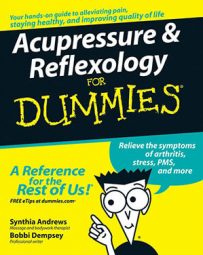The healing arts of acupressure and reflexology are often misunderstood or incorrectly represented. Here are a few common fallacies surrounding these practices.
Acupressure involves needles
Different from acupuncture, acupressure involves no thin needles or sharp instruments at all (in fact, no instruments of any kind). Generally, the only "tools" involved are the practitioner's own two hands. Both acupuncture and acupressure, however, are guided by the principles of Chinese medicine, use acupoints to effect change in meridians, and employ a holistic approach to healing that includes mind, body, emotions, and spirit.
The healing arts are connected to black magic and other spiritual stuff
A basic tenet of the healing arts is the importance and power of positive thoughts and good energy. The healing arts have been (and continue to be) employed by people of all walks of life and many different religions. This belief originated because the concept of energy is so foreign. In general, people are afraid of what they don't know. Science does not yet have the equipment to measure qi, or vital force, directly (skin measurements are indirect measurements of skin conductivity, not direct measurements of an energy output), and research on the effects and benefits of acupuncture, acupressure, and other energy medicine has been scanty. As such, it has easily been misunderstood. Fortunately this is all changing. Medical research is now more plentiful, and the benefits of energy modalities are more accepted.
The healing arts are a substitute for conventional care
The healing arts definitely aren't a substitute for conventional care, and we want to stress that emphatically. The healing arts are used in conjunction with (and as a complement to) necessary medical treatment, not as a replacement. No ethical and responsible healing-arts practitioner would ever claim that these techniques can cure cancer, diabetes, MS, or any other serious medical condition. You should always seek a doctor's care for any painful or chronic medical condition, or for a serious accident, illness, or injury. However, bodywork can stimulate the body's healing mechanism and relieve some of the pain and other symptoms that are caused by these and other medical conditions.
Acupressure and reflexology techniques are painful
Some people believe that acupressure and reflexology techniques are painful. On the contrary, these techniques should make you feel at least a little bit better, often immediately. In some cases, you may experience what's sometimes called "good pain," similar to what you may feel with a really deep stretch or a good massage. However, you should never experience any actual pain — and if you do, you should stop immediately. After a session, some people may experience a healing crisis, which is an exacerbation of symptoms prior to resolution.
Acupressure and reflexology are fancy names for garden-variety massages
Massage, acupressure, and reflexology all employ detailed, specific approaches based on scientific foundations involving the roots of pain and basic physiology. They all have a holistic approach to wellness, interacting with mind, body, and spirit. However, acupressure and reflexology are much more complex practices that include assessing and balancing the flow of energy along meridian or reflex pathways.
Energy is transferable
Many people believe that one person's energy is transferred to another in healing practices. We can't speak for all healing practices, but acupressure and reflexology don't exchange energy between giver and receiver. A basic assumption of this work is that the receiver has everything he needs within himself; it's just out of balance or harmony. Acupressure and reflexology seek to balance the energy of the receiver, not give the receiver energy or take it away.

